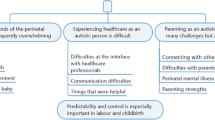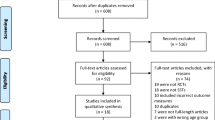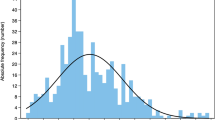Abstract
In spite of the close relationship between gestures and expressive language, little research has examined the roles of the parents’ and children’s gestures in the development of expressive language abilities in autistic children. Previous findings are also inconclusive. In the present study, we coded the gestures produced by the parents and their autistic children in parent-child interactions and compared the influence of their gestures on the children’s expressive language abilities (N = 35; M = 4;10). Autistic children’s deictic gestures positively predicted their Mean Length Utterance (MLU), word types, and word tokens whereas parents’ deictic gesture inputs negatively predicted MLU and word types. The findings shed light on the importance of the gestures made by autistic children, which may trigger parents’ gesture-to-word translation.
Similar content being viewed by others
References
Acosta, L. K. (1981). Instructor use of total communication: Effects on preschool Down’s syndrome children’s vocabulary acquisition and attempted verbalizations (Unpublished thesis). Available from ProQuest Dissertations and Theses
American Psychiatric Association. (2013). Diagnostic and Statistical Manual of Mental Disorders, 5th Edition: DSM-5. Washington, DC: Publisher
Anderson, D. K., Lord, C., Risi, S., DiLavore, P. S., Shulman, C., Thurm, A., & Pickles, A. (2007). Patterns of growth in verbal abilities among children with autism spectrum disorder. Journal of Consulting and Clinical Psychology, 75(4), 594
Azar, Z., Backus, A., & Özyürek, A. (2020). Language contact does not drive gesture transfer: Heritage speakers maintain language specific gesture patterns in each language. Bilingualism: Language and Cognition, 23(2), 414–428
Bang, J., & Nadig, A. (2015). Learning language in autism: Maternal linguistic input contributes to later vocabulary. Autism Research, 8(2), 214–223
Bates, E., Camaioni, L., & Volterra, V. (1975). The acquisition of performatives prior to speech. Merrill-Palmer Quarterly of Behavior and Development, 21(3), 205–226
Blume, J., Wittke, K., Naigles, L., & Mastergeorge, A. M. (2021). Language growth in young children with autism: Interactions between language production and social communication. Journal of Autism and Developmental Disorders, 51(2), 644–665
Braddock, B. A., Pickett, C., Ezzelgot, J., Sheth, S., Korte-Stroff, E., Loncke, F., & Bock, L. (2015). Potential communicative acts in children with autism spectrum disorders. Developmental Neurorehabilitation, 18(4), 260–271
Brignell, A., Williams, K., Jachno, K., Prior, M., Reilly, S., & Morgan, A. T. (2018). Patterns and predictors of language development from 4 to 7 years in verbal children with and without autism spectrum disorder. Journal of Autism and Developmental Disorders, 48(10), 3282–3295
Burgess, S., Audet, L., & Harjusola-Webb, S. (2013). Quantitative and qualitative characteristics of the school and home language environments of preschool-aged children with ASD. Journal of Communication Disorders, 46(5–6), 428–439
Charman, T., Taylor, E., Drew, A., Cockerill, H., Brown, J. A., & Baird, G. (2005). Outcome at 7 years of children diagnosed with autism at age 2: Predictive validity of assessments conducted at 2 and 3 years of age and pattern of symptom change over time. Journal of Child Psychology and Psychiatry, 46(5), 500–513
Choi, B., Nelson, C. A., Rowe, M. L., & Tager-Flusberg, H. (2020a). Reciprocal influences between parent input and child language skills in dyads involving high‐and low‐risk infants for autism spectrum disorder. Autism Research, 13(7), 1168–1183
Choi, B., Shah, P., Rowe, M. L., Nelson, C. A., & Tager-Flusberg, H. (2020b). Gesture development, caregiver responsiveness, and language and diagnostic outcomes in infants at high and low risk for autism. Journal of Autism and Developmental Disorders, 50(7), 2556–2572
Choi, B., Shah, P., Rowe, M. L., Nelson, C. A., & Tager-Flusberg, H. (2021). A longitudinal study of parent gestures, infant responsiveness, and vocabulary development in infants at risk for autism spectrum disorder.Journal of Autism and Developmental Disorders,1–13
Dada, S., Flores, C., Bastable, K., & Schlosser, R. W. (2021). The effects of augmentative and alternative communication interventions on the receptive language skills of children with developmental disabilities: A scoping review. International Journal of Speech Language Pathology, 23:3, 247–257
Duda, M., Kosmicki, J., & Wall, D. (2014). Testing the accuracy of an observation-based classifier for rapid detection of autism risk. Translational Psychiatry, 4(8), e424–e424
Ellis Weismer, S., & Kover, S. T. (2015). Preschool language variation, growth, and predictors in children on the autism spectrum. Journal of Child Psychology and Psychiatry, 56(12), 1327–1337
Fusaroli, R., Weed, E., Fein, D., & Naigles, L. (2019). Hearing me hearing you: Reciprocal effects between child and parent language in autism and typical development. Cognition, 183, 1–18
Georgiades, S., Szatmari, P., Boyle, M., Hanna, S., Duku, E., Zwaigenbaum, L., & Mirenda, P. (2013). Investigating phenotypic heterogeneity in children with autism spectrum disorder: A factor mixture modeling approach. Journal of Child Psychology and Psychiatry, 54(2), 206–215
Goldin-Meadow, S. (2015). From action to abstraction: Gesture as a mechanism of change. Developmental Review, 38, 167–184
Goldin-Meadow, S., Goodrich, W., Sauer, E., & Iverson, J. (2007). Young children use their hands to tell their mothers what to say. Developmental Science, 10(6), 778–785
Goldin-Meadow, S., Mylander, C., de Villiers, J., Bates, E., & Volterra, V. (1984). Gestural communication in deaf children: The effects and noneffects of parental input on early language development.Monographs of the Society for Research in Child Development,1–151
Grelle, L. (2013). Mothers’ conversational patterns: A comparison between typically developing children and young children with autism spectrum disorders. University of Missouri-Columbia
Huang, Y., Wong, M. K. Y., Lam, W. Y., Cheng, C. H., & So, W. C. (2020). Gestures in storytelling by preschool Chinese-speaking children with and without autism. Frontiers in Psychology, 11, 2305
Hus, V., Pickles, A., Cook Jr, E. H., Risi, S., & Lord, C. (2007). Using the autism diagnostic interview—revised to increase phenotypic homogeneity in genetic studies of autism. Biological Psychiatry, 61(4), 438–448
Iverson, J. M., Capirci, O., Longobardi, E., & Caselli, M. C. (1999). Gesturing in mother-child interactions. Cognitive Development, 14(1), 57–75
Kaufman, A. S. (2004). Kaufman Brief Intelligence Test–Second Edition (KBIT—2). American Guidance Service
Konstantareas, M. M., Mandel, L., & Homatidis, S. (1988). The language patterns mothers and fathers employ with their autistic boys and girls. Applied Psycholinguistics, 9(4), 403–414
Lord, C., Rutter, M., DiLavore, P., Risi, S., Gotham, K., & Bishop, S. (2012). Autism diagnostic observation schedule–2nd edition (ADOS—2). Western Psychological Corporation
MacWhinney, B. (2000). The CHILDES Project: Tools for analyzing talk. transcription format and programs (1 vol.). Psychology Press
Manwaring, S. S., Mead, D. L., Swineford, L., & Thurm, A. (2017). Modelling gesture use and early language development in autism spectrum disorder. International Journal of Language & Communication Disorders, 52(5), 637–651
Masi, A., DeMayo, M. M., Glozier, N., & Guastella, A. J. (2017). An overview of autism spectrum disorder, heterogeneity and treatment options. Neuroscience Bulletin, 33(2), 183–193
McNeill, D. (1992). Hand and mind: What gestures reveal about thought. University of Chicago Press
Medeiros, K., & Winsler, A. (2014). Parent–child gesture use during problem solving in autistic spectrum disorder. Journal of Autism and Developmental Disorders, 44(8), 1946–1958
Mishra, A., Ceballos, V., Himmelwright, K., McCabe, S., & Scott, L. (2021). Gesture Production in Toddlers with Autism Spectrum Disorder. Journal of Autism and Developmental Disorders, 51(5), 1658–1667
Mody, M., Manoach, D. S., Guenther, F. H., Kenet, T., Bruno, K. A., McDougle, C. J., & Stigler, K. A. (2013). Speech and language in autism spectrum disorder: A view through the lens of behavior and brain imaging. Neuropsychiatry, 3(2), 223
Mullen, E. M. (1995). Mullen scales of early learning manual. American Guidance Service
Nevill, R., Hedley, D., Uljarevic, M., Sahin, E., Zadek, J., Butter, E., & Mulick, J. A. (2019). Language profiles in young children with autism spectrum disorder: A community sample using multiple assessment instruments. Autism, 23(1), 141–153
Ökcün-Akçamuş, M., Acarlar, F., Keçeli Kaysili, B., & Alak, G. (2019). Examination of the relationship between gestures and vocabulary in children with autism spectrum disorder at different language stages. Early Child Development and Care, 189(5), 777–791
Özçalışkan, Ş., Adamson, L. B., & Dimitrova, N. (2016). Early deictic but not other gestures predict later vocabulary in both typical development and autism. Autism, 20(6), 754–763
Özçalışkan, Ş., Adamson, L. B., Dimitrova, N., & Baumann, S. (2017). Early gesture provides a helping hand to spoken vocabulary development for children with autism, Down syndrome, and typical development. Journal of Cognition and Development, 18(3), 325–337
Özçalışkan, Ş., Adamson, L. B., Dimitrova, N., & Baumann, S. (2018). Do parents model gestures differently when children’s gestures differ? Journal of Autism and Developmental Disorders, 48(5), 1492–1507
Pickles, A., Anderson, D. K., & Lord, C. (2014). Heterogeneity and plasticity in the development of language: A 17-year follow‐up of children referred early for possible autism. Journal of Child Psychology and Psychiatry, 55(12), 1354–1362
Poulton, K. T. (1981). The effects of manual signs, speech and simultaneous communication on comprehension of labels by autistic children. ProQuest Dissertations and Theses.
Ramos-Cabo, S., Vulchanov, V., & Vulchanova, M. (2021). Different Ways of Making a Point: A Study of Gestural Communication in Typical and Atypical Early Development. Autism Research, 14(5), 984–996
Remington, B., & Clarke, S. (1993a). Simultaneous communication and speech comprehension. Part I: Comparison of two methods of teaching expressive signing and speech Comprehension skills. Augmentative and Alternative Communication, 9, 36–48
Rollins, P. R., & Snow, C. E. (1998). Shared attention and grammatical development in typical children and children with autism. Journal of Child Language, 25(3), 653–673
Romski, M., & Ruder, K. F. (1984). Effects of speech and speech and sign instruction on oral language learning and generalization of action-object combinations by Down’s syndrome children. Journal of Speech and Hearing Disorder, 49, 293–302
Rowe, M. L., & Leech, K. A. (2019). A parent intervention with a growth mindset approach improves children’s early gesture and vocabulary development.Developmental Science, 22(4), e12792
Sandbank, M., & Yoder, P. (2016). The association between parental mean length of utterance and language outcomes in children with disabilities: A correlational meta-analysis. American Journal of Speech-Language Pathology, 25(2), 240–251
Silverman, L. B., Eigsti, I. M., & Bennetto, L. (2017). I tawt i taw a puddy tat: Gestures in canary row narrations by high-functioning youth with autism spectrum disorder. Autism Research, 10(8), 1353–1363
So, W. C., Song, X. K., Cheng, C. H., Law, W. W., Wong, T., Leung, O. K., & Huang, Y. (2021). Conversation skills in Chinese-speaking preschoolers with autism: The contributing role of parents’ verbal responsiveness.Journal of Autism and Developmental Disorders,1–14
So, W. C., Wong, M. K. Y., Lui, M., & Yip, V. (2015). The development of co-speech gesture and its semantic integration with speech in 6-to 12-year-old children with autism spectrum disorders. Autism, 19(8), 956–968
Song, X. K., Lee, C., & So, W. C. (2021). Examining phenotypical heterogeneity in language abilities in Chinese-speaking children with autism: A naturalistic sampling approach.Journal of Autism and Developmental Disorders,1–12
Song, X. K., & So, W. C. (2021). The influence of child-based factors and parental inputs on expressive language abilities in children with autism spectrum disorder.Autism
Tager-Flusberg, H., Paul, R., & Lord, C. (2005). Language and communication in autism. Handbook of Autism and Pervasive Developmental Disorders, 1, 335–364
Talbott, M. R., Nelson, C. A., & Tager-Flusberg, H. (2015). Maternal gesture use and language development in infant siblings of children with autism spectrum disorder. Journal of Autism and Developmental Disorders, 45(1), 4–14
Talbott, M. R., Young, G. S., Munson, J., Estes, A., Vismara, L. A., & Rogers, S. J. (2020). The developmental sequence and relations between gesture and spoken language in toddlers with autism spectrum disorder. Child Development, 91(3), 743–753
Tek, S., Mesite, L., Fein, D., & Naigles, L. (2014). Longitudinal analyses of expressive language development reveal two distinct language profiles among young children with autism spectrum disorders. Journal of Autism and Developmental Disorders, 44(1), 75–89
Thurm, A., Manwaring, S. S., Swineford, L., & Farmer, C. (2015). Longitudinal study of symptom severity and language in minimally verbal children with autism. Journal of Child Psychology and Psychiatry, 56(1), 97–104
Venker, C. E., Bolt, D. M., Meyer, A., Sindberg, H., Weismer, E., S., & Tager-Flusberg, H. (2015). Parent telegraphic speech use and spoken language in preschoolers with ASD. Journal of Speech Language and Hearing Research, 58(6), 1733–1746
Wittke, K., Mastergeorge, A. M., Ozonoff, S., Rogers, S. J., & Naigles, L. R. (2017). Grammatical language impairment in autism spectrum disorder: Exploring language phenotypes beyond standardized testing. Frontiers in Psychology, 8;8, 532
Ye, Q., Liu, L., Lv, S., Cheng, S., Zhu, H., Xu, Y. … Deng, H. (2021). The Gestures in 2–4-Year-Old Children With Autism Spectrum Disorder. Frontiers in psychology, 12, 75
Yi, L., Fan, Y., Zhao, J., Huang, D., Li, Y., & Zou, X. (2013). Atypical understanding of mental terms in Chinese-speaking children with autism spectrum disorder. Research in Autism Spectrum Disorders, 7(11), 1411–1417
Zhou, P., Crain, S., Gao, L., Tang, Y., & Jia, M. (2015). The use of grammatical morphemes by Mandarin-speaking children with high functioning autism. Journal of Autism and Developmental Disorders, 45(5), 1428–1436
Acknowledgements
We acknowledge Mui-Fong Wong for supervising the administration of ADOS-2. We are also grateful for the help of our research assistants Chi-Chung Chan, Chun-Ho Cheng, Johnny Fung, Fai-Yeung Kwok, Wing-Wun Law, Shing-Hey Lee, Ying-Yi Lee, Oi-Ki Leung, Jonathan Tse, Ching-Yi Wong, Tiffany Wong, and Yan-Yan Yip with data collection and transcription. Special thanks to all of the children and their parents for their help and dedication to education. This research has been fully supported by a grant from the Innovation and Technology Fund for Better Living (“FBL”; Project no. ITB/FBL/8005/17/P). The authors declare that they have no conflict of interest. All the procedures were approved by the institutional review board of the first author’s university, in compliance with the Declaration of Helsinki (Survey and Behavioral Research Ethics Reference No. SBRE-19-307).
Author information
Authors and Affiliations
Corresponding author
Ethics declarations
Conflict of interest
The authors declare that they have no conflict of interest.
Ethical
All procedures performed in studies involving human participants were in accordance with the ethical standards of the institutional research committee (Survey and Behavioural Research Ethics Reference no. SBRE-19-307) and with the 1964 Helsinki declaration and its later amendments or comparable ethical standards.
Informed consent:
Informed consent was obtained from all individual participants included in the study.
Additional information
Publisher’s Note
Springer Nature remains neutral with regard to jurisdictional claims in published maps and institutional affiliations.
Rights and permissions
About this article
Cite this article
So, WC., Song, XK. Whose Gestures are More Predictive of Expressive Language Abilities among Chinese-Speaking Children with Autism? A Comparison of Caregivers’ and Children’s Gestures. J Autism Dev Disord 53, 3449–3459 (2023). https://doi.org/10.1007/s10803-022-05658-0
Accepted:
Published:
Issue Date:
DOI: https://doi.org/10.1007/s10803-022-05658-0




